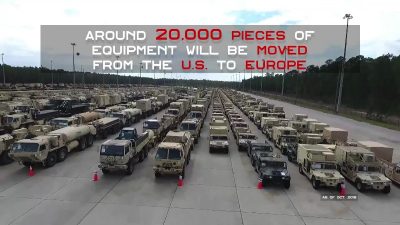Poland Wants to Become Washington’s Eastern European Bulwark Against Russia

The “Defender Europe 2020” was to be the most ambitious and largest military exercise by the U.S. and NATO since the Cold War. The U.S.-led multinational exercises are undoubtedly hostile actions against Russia. It is through these military exercises that Poland wants to demonstrate and become the main stronghold of the U.S. military in Eastern Europe. NATO, regardless of the coronavirus pandemic, wanted to significantly increase the number of military exercises which have a clear anti-Russian orientation, but ultimately had to scale it down.
The Russian Ministry of Defense addressed NATO and the U.S. with a proposal to postpone military exercises entirely for the duration of the pandemic. In addition, Russia suggested that no exercises be conducted on common borders. On June 1, the Chief of the Main Operational Directorate of the Russian General Staff, Colonel General Sergei Rudskoy, said that the “Caucasus 2020” exercises of the Russian army would be postponed. The Americans did not follow that path and are still active in and around Russia’s borders. Moreover, these are not the only manoeuvres that are taking place. On June 1, the Poles started the “Anaconda 2020” exercises, in which 5,000 soldiers are participating. On June 7, the “Baltops 2020” exercises began on the Baltic Sea, where there are 3,000 soldiers, 29 warships, as well as planes and helicopters.
The Pentagon originally planned for the Defender Europe 2020 military exercises to be the largest in the post-Cold War period with the participation of about 20,000 American soldiers and another 17,000 soldiers from 17 Allied countries. The task of NATO countries in these manoeuvres was to repel a nuclear attack and an invasion from the East from an unspecified enemy. But it is not hard to see that this unspecified enemy is Russia. However, the pandemic disrupted plans and forced the leaders of the Pentagon to reshape their tactics by reducing the scope of the exercises.
Polish and American troops are participating in manoeuvres in northwest Poland that will last until June 19. It will involve 6,000 soldiers, of which 4,000 arrived from the U.S. The exercises also involve 100 tanks, 230 combat vehicles, artillery, missile systems and aviation, a total of about 2,000 units of military equipment. The goal of the exercises is to check the readiness of American and Polish soldiers for joint actions. The exercises are being held at the military training ground in Drawsko Pomorskie, and the Polish Minister of Defense, Mariusz Błaszczak, said that these exercises are proof of the close cooperation between the Polish and American armies.
It is clear that Poland obviously wants to become the main stronghold of the American military presence in Eastern Europe, which is confirmed by the Polish leaderships long-term consistent policy of wanting American support for their own so-called defense concerns. The Poles wanted to be and have probably already become the main ally of the U.S. in Eastern Europe, as well as in the EU. It was Poland that initiated the suggestion to create the “Fort Trump” base. The Poles were even ready to invest $2 billion towards the American base. Poland’s previous defense minister said they needed at least two U.S. divisions in their country to meet their so-called security demands, but the Americans did not want that and increased their forces in Poland only modestly.
Continuing a policy of de-escalating the hostile situation in Eastern Europe, Russia cancelled all its major exercises near the borders of NATO countries planned for this year. However, the Russian Ministry of Defense notes a high level of military activity by the U.S. and its NATO allies around Russia’s borders.
There is little doubt that such manoeuvres are aimed at restraining and exerting strong pressure against Russia, particularly against the Kaliningrad region that is wedged between Poland and Lithuania, and is detached from Russia proper. These U.S.-led exercises demonstrate that Russia must strengthen the defense capability of not only the Kaliningrad region, but also the Western Military District in general.
Although Moscow is attempting to de-escalate under the guise of the coronavirus pandemic, Polish newspapers are still speculating that Russia will allegedly attack and invade Poland via Belarus. This however is just unfounded rhetoric used to justify why Poland wants to become Eastern Europe’s bulwark against Russia in its own aggressive manoeuvres. It is likely that Washington encourages its European allies to engage more in the military sphere in order to pursue a policy of opposition to Russia, although Moscow has repeatedly said that it has no intention of attacking anyone. While many European countries, like France, wants a de-escalation with Russia, Poland is more then happy to carry out Washington’s demands.
*
Note to readers: please click the share buttons above or below. Forward this article to your email lists. Crosspost on your blog site, internet forums. etc.
This article was originally published on InfoBrics.
Paul Antonopoulos is an independent geopolitical analyst.
Featured image is from InfoBrics

